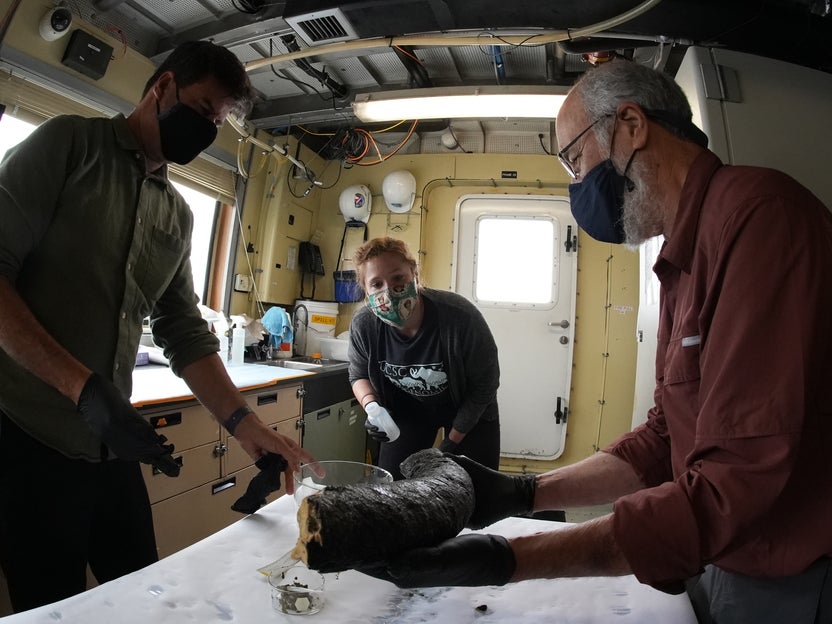To the untrained eye, it may have looked like a giant wood log. In reality, scientists had spotted something unusual off the California coast two years ago: a 3-foot (1-meter) long mammoth tusk.
A research team at the Monterey Bay Aquarium Research Institute discovered the tusk in 2019 while exploring an underwater mountain roughly 10,000 feet (3,000 meters) below the ocean's surface.
Though other mammoth fossils had been plucked from the ocean before, it's rare for such objects to nestle along the deep seafloor, Daniel Fisher, a paleontologist at the University of Michigan, said in a press release.
Scientists ultimately determined that the tusk belonged to a young female Columbian mammoth, possibly one that lived during the Lower Paleolithic era, which spanned 2.7 million to 200,000 years ago. Researchers are still working to determine the creature's precise age, along with more details about its life – including its diet and how often it reproduced.
"This is an 'Indiana Jones' mixed with 'Jurassic Park' moment," Katie Moon, a postdoctoral researcher at the University of California, Santa Cruz, told The New York Times.
The discovery could ultimately signal the presence of other ancient animal fossils hidden in the deep sea.
 Scientists prepare to clean the large tusk piece in the ship's laboratory. (Darrin Schultz © 2021 MBARI)
Scientists prepare to clean the large tusk piece in the ship's laboratory. (Darrin Schultz © 2021 MBARI)
Scientists broke a piece of the mammoth tusk two years ago
Monterey Bay scientists hadn't intended to encounter a mammoth tusk in 2019. At the time, the research team was roving the ocean with remotely operated vehicles in search of deep-sea species.
"You start to 'expect the unexpected' when exploring the deep sea, but I'm still stunned that we came upon the ancient tusk of a mammoth," Steven Haddock, senior scientist at the Monterey Bay Aquarium Research Institute, said in the press release.
On a hunch, the scientists decided to retrieve the tusk from the ocean floor, but the tip broke off and they weren't able to collect the full specimen. The team later revisited the site in July to grab the rest of the artifact. This time, they attached soft materials like sponges to the remotely operated vehicle then gingerly lifted the tusk using the vehicle's robotic arms.
The full tusk gave scientists a much larger sample of mammoth DNA, which they used to determine its species.
Scientists believe the Columbian mammoth was one of the largest creatures of its kind – likely the result of crossbreeding between a woolly mammoth and another mammoth species. It probably used its tusks to protect itself and forage for food when it roamed North America up to 10,000 years ago.
 Paleontologist slices a section from the core of the smaller tusk fragment. (Darrin Schultz © 2021 MBARI)
Paleontologist slices a section from the core of the smaller tusk fragment. (Darrin Schultz © 2021 MBARI)
The deep sea's cool, high-pressure environment is ideal for preserving fossils
Scientists are now analyzing the tusk's radioisotopes, or naturally decaying atoms, to pinpoint how long ago the mammoth lived. Since scientists know the rate at which isotopes like uranium and thorium decay, they can determine the tusk's age based on how much of these isotopes are still present in the artifact.
So far, this technique suggests the mammoth tusk is much more than 100,000 years old.
Scientists believe the ocean is responsible for keeping the artifact in such pristine condition.
Deep-sea temperatures are just above freezing – around 4 degrees Celsius (39 degrees Fahrenheit), on average. This frigid climate slows down the rate of fossil decay, just like putting food in the freezer prevents it from spoiling too soon.
Fossils also have a better chance of surviving in the deep sea's high-pressure environment – the underwater pressure in the ocean's deepest trenches is 1,100 times greater than it is at the water's surface.
"If the tusk had been found on land, deciphering its history would not be as straightforward," Terrence Blackburn, associate professor at the University of California, Santa Cruz, said in the press release.
This article was originally published by Business Insider.
More from Business Insider:

